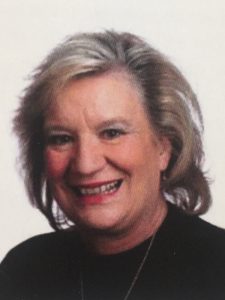
The following article is a reprint from the 2016 National Blue Ribbon Award Ceremony Program.
The Terrell H. Bell Award for Outstanding Leadership is awarded to principals who have transformed their schools. Their vision and collaborative leadership styles have produced outstanding results for all of their students regardless of race, language proficiency, or socioeconomic status. Dr. Judy Armstrong was one of eight recipients honored and the only Catholic school principal to receive this award.
—
Dr. Judy Armstrong began her doctorate studies in leadership around the time A Nation at Risk was published, and that seminal report continues to have a strong influence on her leadership. As a principal at St. Thomas More, Dr. Armstrong strives to develop and implement a rigorous, engaging, and dynamic academic environment that fulfills the needs of her students while providing a supportive and nurturing school community. Guided by a strong belief in situational leadership and the importance of collaboration, she and the school have been able to adapt to a changing and unexpected world.
When Dr. Armstrong was hired as principal eleven years ago, St. Thomas More was dealing with shifting neighborhood demographics and major changes in the makeup of the student population. St. Thomas More was transitioning from a neighborhood school to one in which families traveled to attend. On top of that issue, just three weeks into Dr. Armstrong’s administration, Hurricane Katrina struck the Gulf Coast and caused evacuation of New Orleans. Dr. Armstrong and the St. Thomas More community embraced the challenge of educating displaced students. Approximately 440 students of varying socio-economic, ethnic, and academic backgrounds were granted admission to St. Thomas More, making it one of the largest K-8 schools in the region in less than one week. This unexpected influx intensified the need to grapple with both the immediate and ongoing population changes the school was facing.
In order to best serve a more diverse student body, Dr. Armstrong sought new ways to address students’ varied interests and academic needs while empowering the faculty and guiding them to expand their teaching practices in support of differentiation. She fortified the performing arts curriculum and provided opportunities for students to share their talents, and she built in opportunities for engineering, math, and science enrichment. To further support student academic and social needs, Dr. Armstrong expanded the extended day learning opportunities such as robotics, Future City, design teams, drama, and computer lab/homework support.
When test analyses indicated inconsistency in the English/language arts scores of minority and displaced students, Dr. Armstrong formulated a plan to address the disparity. She worked with faculty to evaluate data, identify areas of weakness, and help students adapt through cooperative learning groups, peer tutoring, and variance in content presentation. To further enhance these efforts, Dr. Armstrong enlisted a team of two guidance counselors, a reading specialist, a resource specialist, a school nurse, and an Individual Needs Committee to offer support to students of all learning modalities by monitoring their progress and providing individualized and group instruction. Teaching assistants provided lower grade students with additional support. With differentiated instructional practices and focused reinforcement of the support staff, the variance in the test scores of St. Thomas More’s minority and displaced students was no longer statistically significant at their graduation.
When Dr. Armstrong arrived, the student performance measures at St. Thomas More indicated the need for curriculum adjustments. To address them, she brought the faculty together to develop a cohesive, sequential curriculum designed to raise test scores through thoughtful planning, innovative teaching strategies, and technology integration. Teachers formed professional learning teams, and Dr. Armstrong designated days throughout the instructional year for weekly grade-level meetings, monthly faculty meetings, subject matter discussions, vertical subject area team meetings, and jigsaw discussions. Additionally, she implemented Summer Institute days where teachers received stipends to develop curriculum maps and instructional units. Teachers were invited to serve on school-based advisory teams (such as school Improvement, Safety Committee, Individual Student Needs Committee, Curriculum Committees), empowering them to share professional opinions and embrace change for St. Thomas More and individual student adjustment plans.